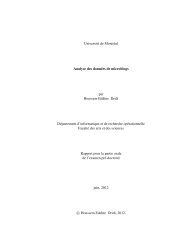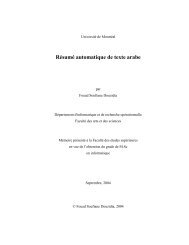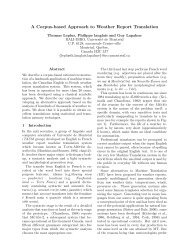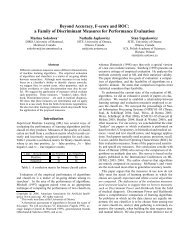Designing a Machine Translation System for Canadian Weather ...
Designing a Machine Translation System for Canadian Weather ...
Designing a Machine Translation System for Canadian Weather ...
Create successful ePaper yourself
Turn your PDF publications into a flip-book with our unique Google optimized e-Paper software.
<strong>Designing</strong> a <strong>Weather</strong> Warning <strong>Translation</strong> <strong>System</strong> 16<br />
to be filtered out. One filtering rule examines the agreement between the serialization<br />
tokens found in the source phrase and those found in the target phrase.<br />
A phrase pair is rejected when a target phrase contains at least one serialization<br />
token without a counterpart in the source sentence. This is often caused by a word<br />
alignment problem or rephrasing, as in the misaligned pair (“A NUM CM PAR<br />
ENDROITS”, “ NUM TO LOCALLY NUM CM”). If the source phrase is a lone token,<br />
then the translation must be the same, or the pair is rejected. We also wrote<br />
rules to filter out phrase pairs like (“DE LA GRELE DE NUM CM .”, “ NUM MM<br />
HAIL .”), containing an unsafe conversion of units, a problem that would have<br />
otherwise gone undetected by the deserialization process.<br />
5.1 Variants Tested<br />
We experimented with different parameters of the translation pipeline, <strong>for</strong> both<br />
translation directions. For all the variants, we always filter the phrase table first<br />
using the procedure described above. These experiments were prompted by various<br />
problems we observed in the quality of preliminary translations.<br />
5.1.1 Reordering Model<br />
During the development of Watt, we noticed that unknown words in the source<br />
resulted in quasi-gibberish in the translations, often due to the seemingly haphazard<br />
way in which the target phrases were reordered around the unknown word. We<br />
there<strong>for</strong>e decided to verify how phrase reordering strategies impacted the quality of<br />
the translation, and whether their use was warranted at all. We tuned and tested<br />
three variants of the SMT’s reordering model:<br />
none Target phrases are produced in a monotone fashion, and the only possible<br />
changes in word order are within the confines of a given target phrase.<br />
distance The model sets a cost proportional to the reordering distance, counted<br />
in phrases. The maximum “skip” is set to 6.<br />
msd An additional lexicalized reordering model is trained and used when decoding.<br />
Three different phrase orientations are possible: monotone, swap and discontinuous,<br />
based on the previous and following phrase, and conditioned on<br />
source and target languages. (Koehn et al. 2007) describe this more elaborate<br />
but nonetheless commonly used model.<br />
5.1.2 Phrase Filtering<br />
Another apparent source of errors in translations was word misalignments, which in<br />
turn caused the presence of spurious phrase pairs in the phrase-based model used by<br />
Moses. One such phrase pair erroneously associated “BALAIE” (French <strong>for</strong> “sweeps”)<br />
with the translation “CHIBOUGAMAU TOWARD LAKE ERIE WILL SWEEP” and caused<br />
the two locations (Chibougamau and Lake Erie) to appear out of thin air in a translation.<br />
Although its associated scores are very low, the pair’s target still showed up<br />
in our preliminary tests. This prompted us to attempt to sanitize the phrase-based











